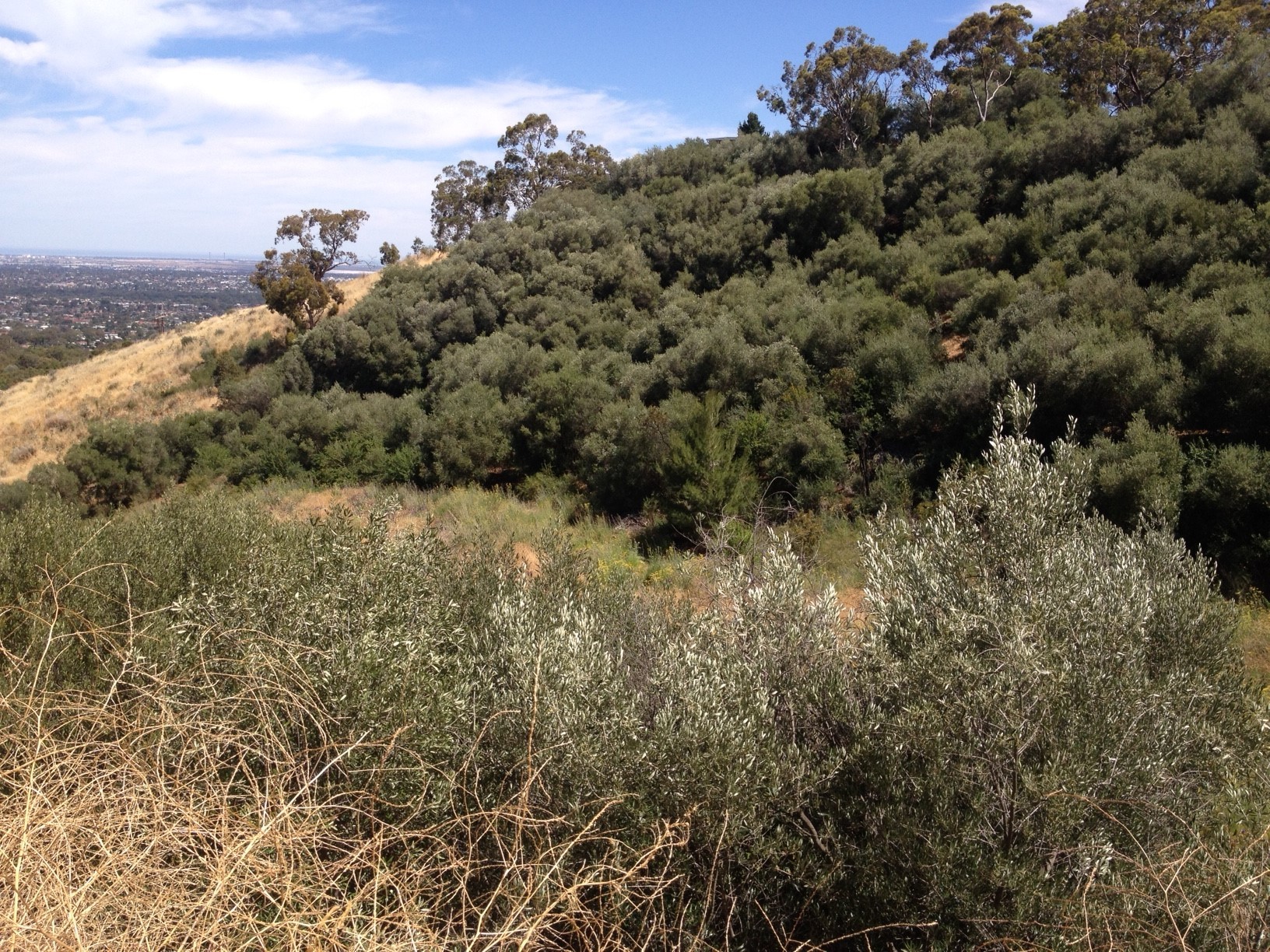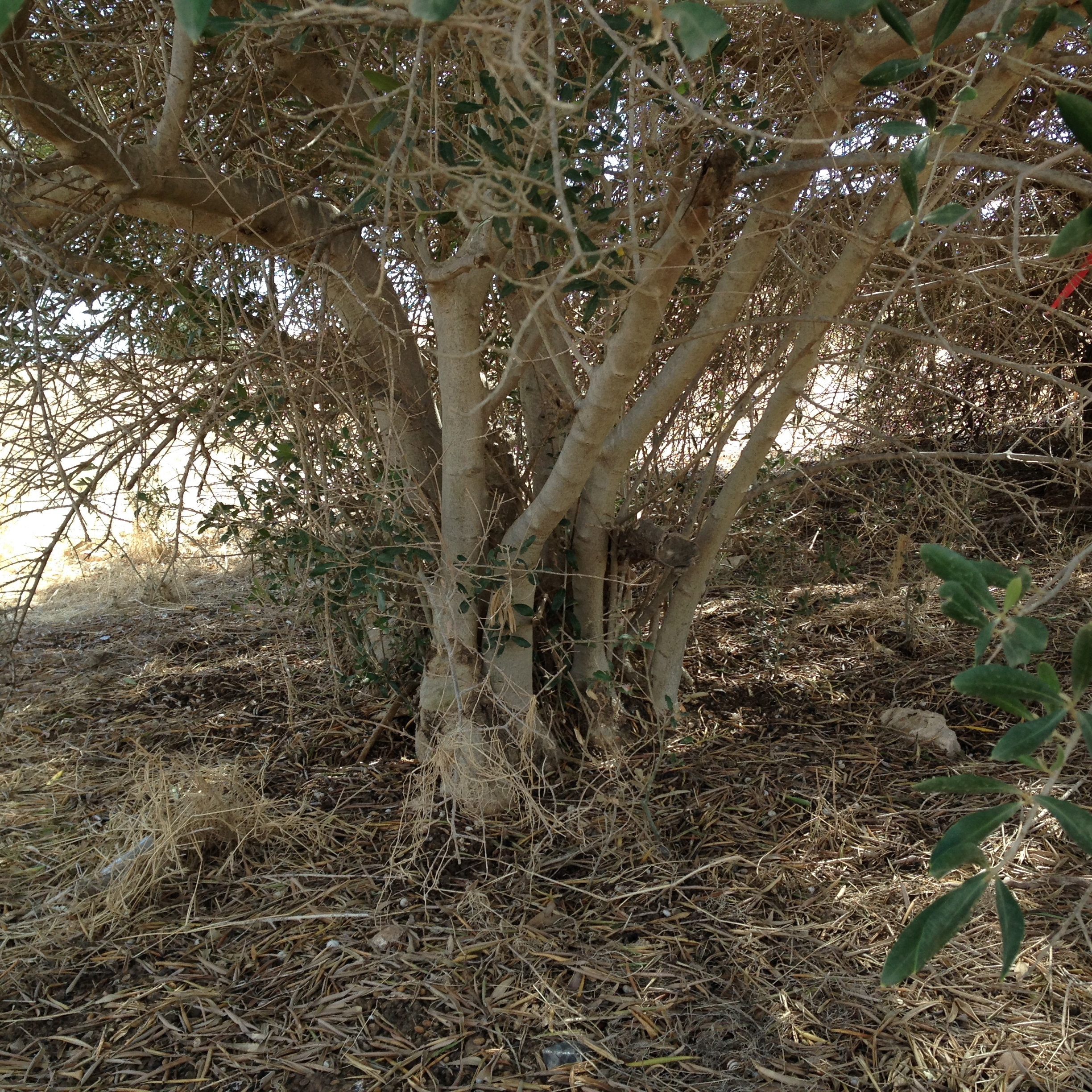Feral European olives are a major pest in native vegetation where they displace local species and degrade habitat for animals. They’re oil-rich, making them a significant bushfire hazard.
Why is feral olive a problem?
Feral olive is a major pest in grassy woodlands. It is a strong competitor and develops a dense mid-storey that outcompetes shrubs and suppresses the growth of ground-layer plants. In severe infestations the understorey can be almost completely bare, which creates an erosion risk, particularly along watercourses.
Olive trees are rich in oil and burn with intense heat. They make the impact of bushfires on native vegetation worse and significantly increase the danger of firefighting.

What does feral olive look like?
European olive is an upright, bushy tree that grows to 12 metres tall. The trunk branches from the base and has rough grey to black bark. Leaves are narrow, glossy and dark green on top, and silvery underneath. Small cream flowers with four petals appear in large clusters in late spring.
Mature trees produce thousands of fruit each year, each containing one seed. The fruit is initially green and becomes purple-black as it ripens over summer. Seeds germinate mainly in autumn and seedlings grow during winter. It takes several years for new plants to flower and set seed.

How does feral olive spread?
Birds and mammals, including foxes, seek out the oil-rich fruit and unintentionally spread the seeds. This can result in the dispersal of seed over many kilometres and new infestations establishing.
Seeds may also be transported in contaminated soil with earthworks and by dumped green waste.
Feral olives have a deep root system that branches out underground. A large, round, woody growth at the base of the plant (known as a lignotuber) stores energy and generates new stems.
Even after being cut back or removed, new shoots and suckers can develop from the woody roots.

How to get rid of feral olive on your property
Effective control requires a long-term plan. The trees are hardy, have vigorous and persistent root systems and many long-lived seeds.
Consider which control method is best for your situation and reduces off-target risk to the environment and native vegetation. Regrowth and ongoing germination require continued control. For advice on chemical options go to PIRSA's Identifying declared weeds.
Chemical treatment options can be applied all year, however avoid hot periods when plants may be stressed as they are not actively growing and won’t take up the herbicide as effectively.
All work should be monitored for several years with regrowth or new seedlings treated.
Hand pulling / grubbing
Hand pulling is suitable when seedlings are small and in winter when soils are moist, making the plant and roots easier to remove. A grubber or ‘tree popper’ can also be used in winter when the soil is moist. Suitable for plants with stems from 6 cm to 1.5 m high. Any disturbed soil should be packed down after removal.
Cut and swab
Cut the trunk as low as possible and paint (aka swab) with a registered herbicide within 20 seconds. Suitable for small seedlings and trees where minimal soil disturbance is desired.
Drill and fill
Drill holes 2–3 cm deep into the lignotuber and trunk, about 40 mm apart and a minimum of three rows. Then apply a registered herbicide to the holes within 20 seconds. Suitable for small and mature trees. Once dead, bare trees can be left in situ to provide habitat or sentry points for birds, or removed at a later time.
Frill and fill
Use a hatchet or chainsaw to cut grooves around the lignotuber and trunk, 2–3 cm deep, about 40 mm apart, at a 450 angle and for a minimum of three rows (the more the better). Be careful not to ringbark the plant i.e. create a continuous cut around the whole trunk, as it may stop the movement of the chemical through the tree. Fill each groove or cut with herbicide within 20 seconds. Suitable for small and mature trees.
Spot spray
Use a registered herbicide as recommended on the label. Suitable for targeting seedlings and small plants up to 1.5 m tall.
Mechanical removal
Mature trees and their stumps can be bulldozed or mechanically removed, however the potential damage this may cause to soils needs to be considered.
Removing vegetation growing in a watercourse, lake, or on the floodplain of a watercourse, may require a Water Affecting Activity permit.
Basal treatment
Basal bark treatment is suitable for smaller and smooth barked trees. Chemical is applied to cover lower trunk and stems, recommended at a rate of 1lt Triclopyr 600 g/l to 30 litres of diesel oil, as per label and APVMA permit number PER91974.
No matter which treatment is used, all controls should be monitored and any regrowth or new seedlings treated.
Is feral olive a declared weed?
Feral olives are a declared weed under the Landscape South Australia Act 2019. Cultivated trees, planted and maintained for use, are not declared.
Observations of weeds can be entered into iNaturalist, an app which can assist with identification of species.
Main image courtesy of Monica Seiler.